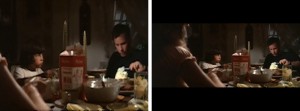Ana de Almeida
Uniforma
“This program is presented in the new PALPlus panoramic format, supported by the European Union”.
In 1997 RTP, the Portuguese public broadcaster started to include a few programs featured in a 16:9 format. Two white arrows would stretch the image in the television screen and the stars of the European Union flag would appear whirling, meanwhile a strong male voice off briefly presented the new format and the Union as its supporter. Afterwards the show would start.
Following the presentation of the new 16:9 analogical PALPlus format at the International Consumer Electronics Exhibition in Berlin, in 1993, the European Union approved a plan to support the production and broadcast of 16:9 programs. This standardization process was considered mainly to be an attempt of approximation to the cinematographic wide screen format.
Standardization processes are something that we are used to and that we easily relate to the European Union, quality and safety and yet uniformazation is a negatively connoted term binded with a (constantly updated) collective memory of totalitarianism.
At the Mz.Baltazar’s display I will present the first outcomes of an artistic research about the historical, political and practical aspects of image formatting.
The main question of my research is the one of in which way did the conversion to the 16:9 wide screen format, agreed upon by the European Union and the United States constituted a fundamental piece for the construction of an European identity?
The first stage of this project leads to a reflection upon the relation between image formatting decisions and the audiovisual market. Are these also practical decisions that have in view an internationalization and democratization of the image, or do they only serve economic purposes, as the production of new devices and equipments?
The power of uniformization and standardization always belonged to the biggest economical powers and 4:3 to 16:9 is a global process that shapes the production and reception of the moving image.
About the artist:
Ana de Almeida is from Lisbon, Portugal.
She lives and works in Vienna.
www.anadealmeida.com
About Windowshop project & Mz Baltazar’s Laboratory
The mission of the Luftsteuer Exhibition Project (2013) is to encourage and support solo exhibition projects by artists who call themselves women or trans. The exhibition program is a Mz. Baltazar’s Laboratory project, currently based in a ground-floor atelier at Sechshauserstraße 28, in 15th district, Vienna. Mz. Baltazar’s Laboratory is non-profit organization that playfully demystifies technology by opening up a world where learning new technological tools is fearless, interesting and clear for creative women of all ages. Mz. Baltazar’s participants and organizers come from different backgrounds and mindsets to exchange equipment, knowledge, build circuits, play with DIY electronics and interactive art. We encourage each other to learn new tools and collaborate in theory and art groups, workshops and meetings, therefore creating a tech women community.
Ein Luftsteuer – show window Projekt
Uniforma
“This program is presented in the new PALPlus panoramic format, supported by the European Union”.
1997 begann die öffentlich-rechtliche Fernsehanstalt in Portugal einige Sendungen im neuen 16:9 Format zu lancieren. Auf dem Bildschirm erschienen zwei weiße Pfeile die das Fernsehbild auseinanderziehen und die Sterne der EU-Flagge zu kreisen beginnen. Aus dem Off ertönt eine markante Männerstimme, die in kurzen Sätzen das neue Format und die EU als dessen Unterstützerin vorstellt. Danach beginnt die Show.
Die portugiesische Künstlerin Ana de Almeida erforscht in ihrer künstlerischen Arbeit Uniforma, anhand des oben beschriebenen Ereignisses im Portugiesischen Fernsehen, inwieweit Standardisierungsprozesse dazu beitragen eine gemeinsame europäische Identität zu formen. Dabei lotet sie den schmalen Grat zwischen Qualitätssicherung, Vereinfachung und Einheitlichkeit einerseits und der im Kollektiven Gedächtnis als negativ und erschreckend konnotierten Erfahrungen von Gleichmacherei und Totalitarismus aus.
Die Künstlerin
Ana de Almeida, geboren in Lissabon / PT, Studierte Mixed Media Art und Malerei am Lahti Institute of Fine Arts, Finland und Lissabon Faculty of Fine Arts, Portugal.
2011 absolvierte sie einen Master of Critical Studies an der Akademie der Bildenden Künste, Wien.
Ana de Ameida lebt und arbeitet in Wien.

